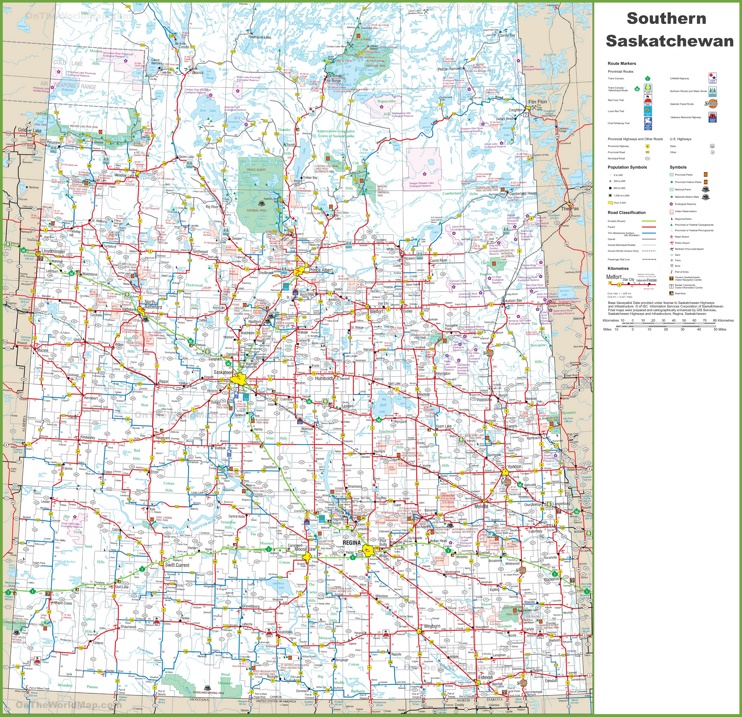Map of Southern Saskatchewan
Description:
This map shows cities, towns, rivers, lakes, Trans-Canada highway, major highways, secondary roads, national parks, provincial parks, historic sites, ecological reserves, indian reservations, regional parks, campgrounds, airports, ferries, tourism visitor reception centres, and rest areas in Southern Saskatchewan.
Size: 5180x5005px / 9.92 Mb
You may download, print or use the above map for educational, personal and non-commercial purposes. Attribution is required. For any website, blog, scientific research or e-book, you must place a hyperlink (to this page) with an attribution next to the image used.
Description:
This map shows cities, towns, rivers, lakes, highways, and major roads in Southern Saskatchewan.
Size: 1625x1688px / 1.39 Mb
You may download, print or use the above map for educational, personal and non-commercial purposes. Attribution is required. For any website, blog, scientific research or e-book, you must place a hyperlink (to this page) with an attribution next to the image used.
About Southern Saskatchewan
Southern Saskatchewan: The Heartland of Canada's Prairies
Southern Saskatchewan forms part of the Great Plains of North America, rising to about 2,000 feet above sea level. This region represents the agricultural core of the province and serves as Canada's breadbasket. The landscape is characterized by vast stretches of grasslands and fertile soil, making it ideal for farming despite challenging climate conditions. The area experiences extreme temperature variations, from as low as -53°C in winter to scorching 41°C in summer, with relatively modest annual precipitation of 10-20 inches, primarily occurring during summer months.
The economy of Southern Saskatchewan has historically been dominated by agriculture. The region produces approximately 45% of Canada's wheat and has diversified into other crops including canola, flax, lentils, chickpeas, and peas. In fact, Saskatchewan grows 99% of Canada's lentils, 85% of its chickpeas, and 75% of its peas. Since the mid-20th century, the discovery of significant oil and natural gas reserves has transformed the economy, making Saskatchewan second only to Alberta in petroleum production within Canada.
Natural Resources and Geography
While agriculture remains vital, Southern Saskatchewan possesses substantial mineral wealth. The province contains about 75% of the world's recoverable potash reserves, primarily located in the central and southern regions. These resources have contributed to economic diversification and growth. The southern portion of Saskatchewan also contains the Cypress Hills, which at 4,567 feet represent the highest point between Labrador and the Rocky Mountains, contradicting the common perception of Saskatchewan as entirely flat.
The rivers of Southern Saskatchewan primarily belong to the Mississippi basin, eventually flowing into the Gulf of Mexico. This hydrological connection underscores the region's continental position at the heart of North America. The province is unique in Canada as the only one with entirely artificial borders, sharing boundaries with Alberta to the west, Manitoba to the east, and the U.S. states of Montana and North Dakota to the south.
European exploration of the area began in 1690, with permanent settlements established by 1774. Following the suppression of Louis Riel's Second Rebellion in 1885, Canadian authorities encouraged European immigration. Under the Dominion Lands Act, settlers could obtain 160 acres for a nominal fee if they established farms. Saskatchewan officially became a province in 1905, with Regina designated as the capital. Today, despite its rural character, approximately half of Saskatchewan's population resides in its two major cities: Regina and Saskatoon.
Maps of Saskatchewan: Large detailed tourist map of Saskatchewan with cities and towns | Saskatchewan Road Map | Saskatchewan Highway Map | Saskatchewan rail map | Map of Northern Saskatchewan | Saskatchewan Bus Map
Maps of Canada
Provinces and Territories
Cities of Canada
Cities of Canada


